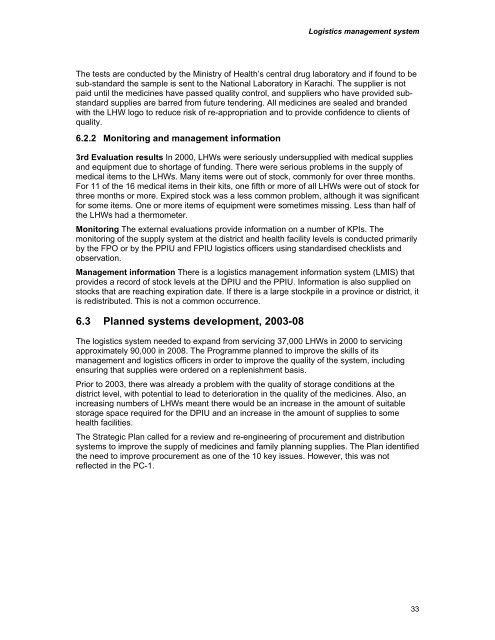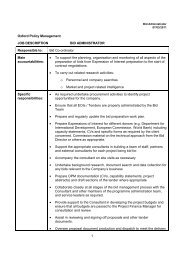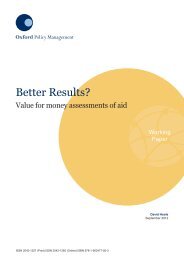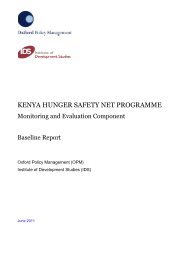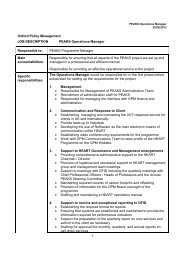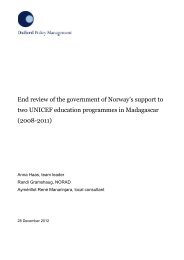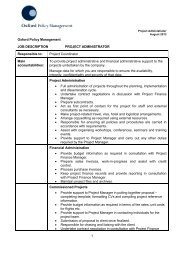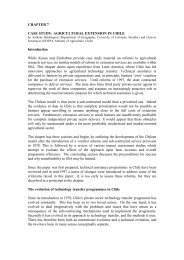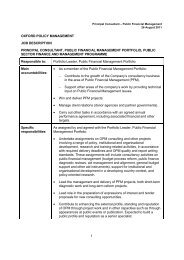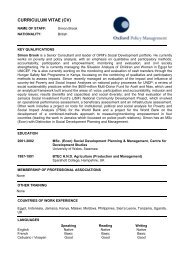LHW Systems Review - Oxford Policy Management
LHW Systems Review - Oxford Policy Management
LHW Systems Review - Oxford Policy Management
You also want an ePaper? Increase the reach of your titles
YUMPU automatically turns print PDFs into web optimized ePapers that Google loves.
Logistics management systemThe tests are conducted by the Ministry of Health’s central drug laboratory and if found to besub-standard the sample is sent to the National Laboratory in Karachi. The supplier is notpaid until the medicines have passed quality control, and suppliers who have provided substandardsupplies are barred from future tendering. All medicines are sealed and brandedwith the <strong>LHW</strong> logo to reduce risk of re-appropriation and to provide confidence to clients ofquality.6.2.2 Monitoring and management information3rd Evaluation results In 2000, <strong>LHW</strong>s were seriously undersupplied with medical suppliesand equipment due to shortage of funding. There were serious problems in the supply ofmedical items to the <strong>LHW</strong>s. Many items were out of stock, commonly for over three months.For 11 of the 16 medical items in their kits, one fifth or more of all <strong>LHW</strong>s were out of stock forthree months or more. Expired stock was a less common problem, although it was significantfor some items. One or more items of equipment were sometimes missing. Less than half ofthe <strong>LHW</strong>s had a thermometer.Monitoring The external evaluations provide information on a number of KPIs. Themonitoring of the supply system at the district and health facility levels is conducted primarilyby the FPO or by the PPIU and FPIU logistics officers using standardised checklists andobservation.<strong>Management</strong> information There is a logistics management information system (LMIS) thatprovides a record of stock levels at the DPIU and the PPIU. Information is also supplied onstocks that are reaching expiration date. If there is a large stockpile in a province or district, itis redistributed. This is not a common occurrence.6.3 Planned systems development, 2003-08The logistics system needed to expand from servicing 37,000 <strong>LHW</strong>s in 2000 to servicingapproximately 90,000 in 2008. The Programme planned to improve the skills of itsmanagement and logistics officers in order to improve the quality of the system, includingensuring that supplies were ordered on a replenishment basis.Prior to 2003, there was already a problem with the quality of storage conditions at thedistrict level, with potential to lead to deterioration in the quality of the medicines. Also, anincreasing numbers of <strong>LHW</strong>s meant there would be an increase in the amount of suitablestorage space required for the DPIU and an increase in the amount of supplies to somehealth facilities.The Strategic Plan called for a review and re-engineering of procurement and distributionsystems to improve the supply of medicines and family planning supplies. The Plan identifiedthe need to improve procurement as one of the 10 key issues. However, this was notreflected in the PC-1.33


